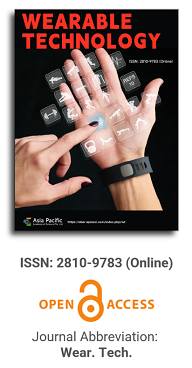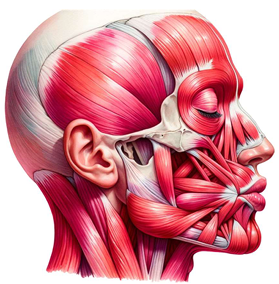

This paper delves deeply into the innovative realm of integrating human emotions with wearable technology. The primary focus is on the conceptualization and development of a kiss transfer device that harnesses the power of wearable technology to bridge the physical gap in human-human interactions. By investigating the intricate nuances of the human-human kissing process, the research seeks to replicate this intimate gesture through a technological medium. The paper not only elaborates on the anatomy, evolution, and hormonal dynamics of kissing but also underscores the transformative potential of wearable technology in capturing and transmitting these intimate moments. This exploration opens up new horizons for long-distance relationships, offering a tangible touchpoint that goes beyond traditional communication methods. Through this pioneering work, the research positions wearable technology as not just a tool for communication but as an extension of our human emotions and expressions.

Overview of intelligent clothing and accessories technology system for the disabled
Vol 2, Issue 1, 2021
Download PDF
Abstract
The purpose of this paper is to explore the application of intelligent technology in the industry of the disabled. Through the systematic review of databases (redib, doaj, redalyc, bmj, bvs, dialnet and pubmed), 11 articles were obtained, describing the intelligent technology in ves-tiles devices, which are designed to help patients recover. In an interdisciplinary field, especially in the field of social sciences, there is a new and underutilized phenomenon. This review shows that further research is needed to expand this topic.
Keywords
References
- De Souza Godinho S. Moda, vestimenta y discapacidad. Tesis de Doctorado en Sociología [PhD thesis]. Pontificia Universidad Católica Argentina 2019.
- Kaiser S. The Social psychology of clothing. symbolic appearancesin context. Macmillan.
- Baker SM, Holland J, Kaufman Scarborough C. How consumers with disabilities perceive “welcome” in retail servicescapes: A criticalincident study. Journal of Services Marketing 2007; 21 (3): 160–173.
- De Souza Godinho S. Los mecanismosde la moda en la discapacidad [The mechanisms of fashion in disability]. Revista Inclusiones v.3. Número Especial/Enero–Marzo 2016; 59–76.
- Silva LMD. O estranhamentocausado pela deficiência: preconceitoe experiência [The strangeness caused by disability: prejudice and experience]. Revista Brasileira De Educação 2006; 11(33): 424–434.
- Carroll KE, Kincade DH. Inclusive design in apparel product development for working women with physical disabilities. Family and Consumer Sciences Research Journal 2007; 35(4): 289–315.
- Meinander H, Varheenmaa M. Clothing and textiles for disabled and elderly people, Vtt Tiedotteit. A Research Notes, 2143 2002.
- Mann S. Smart clothing: The wearable computer and wearcam. Personal Technologies 1997; 1(1): 21–27.
- Lobo MA, Hall ML, Greenspan B,et al.Wearables for pediatric rehabilitation: How to optimally design and use products to meet the needs of users. Physical Therapy 2019; 99(6): 647–657.
- Dittmar A, Meffre R, De Oliveira F, et al.(2008) Wearable medical devices using textile and flexible technologies for ambulatory monitoring. In 2005 IEEE Engineering in Medicine and Biology 27th Annual Conference, 7161–7164.
- Dantas D. Diseño centrado en el sujeto: una visión holística del diseño rumbo a la responsabilidad social [Subject-Centered design: A holistic view of design for social responsibility]. Cuadernosdel Centro de Estudios en Diseño y Comunicación. Ensayos 2014; (49): 51–61.
- Tao XM. Smart technology for textiles and clothing–Introduction and review. Woodhead Pub 2001.
- Chen M, Ma Y, Song J, et al. Smart clothing: Connecting human with clouds and big data for sustainable health monitoring. Mobile Networks and Applications 2016; 21(5): 825–845.
- Bullough WA. Smart Fluid Machines.(translated by K Worden, WA Bullough, J Haywood). Smart Technologies 2003; 193–219.
- Zambrini L. Indumentaria y tecnología: introducción al diseño textil inteligente [Apparel and technology: introduction to smart textile design]. Moda Documenta: Museu, Memória e Design 2015; 2(1).
- De Souza Godinho S. Diseñointeligente: La inclusión social por medio de la vestimenta [Smartdesign: social inclusion through clothing]. Revista Argentinade Sociología 2019; 15(25): 91–115.
- Papi E, Belsi A, McGregor AH. A knee monitoring device and the preferences of patients living with osteoarthritis: a qualitative study. BMJ Open 2015; 5(9).
- Lee SI, Campion A, Huang A, et al. Identifying predictors for postoperative clinical outcome in lumbar spinal stenosis patients using smart–Shoe technology. Journal of Neuroengineering and Rehabilitation 2017; 14(1): 77.
- Papi E, Murtagh GM, McGregor AH. Wearable technologies in osteoarthritis: A qualitative study of clinicians’ preferences. BMJ Open 2016; 6(1).
- Biggar S, Yao W. Design and evaluation of a soft and wearable robotic glove for hand rehabilitation. IEEE Transactions on Neural Systems and Rehabilitation Engineering 2016; 24(10): 1071–1080.
- Ming A, Walter I, Alhajjar A, et al. Study protocol for a randomized controlled trial to test for preventive effects of diabetic foot ulceration by telemedicine that includes sensor–Equipped insoles combined with photo documentation. Trials 2019; 20(1): 521.
- Hall SS, Kandiah J, Saiki D, et al. Implications of smart wear technology for family caregiving relationships: Focus group perceptions. Social Work in Health Care 2014; 53(9): 994–1014.
- Ma Z, Ben Tzvi P, Danoff J. Hand rehabilitation learning system with an exoskeleton robotic glove. IEEE Transactions on Neural Systems and Rehabilitation Engineering 2015; 24(12): 1323–1332.
- Lee SI, Park E, Huang A, et al. Objectively quantifying walking ability in degenerative spinal disorder patients using sensor equipped smart shoes. Medical Engineering & Physics 2016; 38(5): 442–449.
- Biggar SJ, Yao W, Wang L, et al. User-Centric feedback for the development and review of a unique robotic glove prototype to be used in therapy. Journal of Healthcare Engineering 2017; 1–8.
- Esmail A, Poncet F, Rochette A, et al. The role of clothing in participation of persons with a physical disability: A scoping review protocol. BMJ Open 2018; 8(3).
- Hatton AL, Gane EM, Maharaj JN, et al. Textured shoe insoles to improve balance performance in adults with diabetic peripheral neuropathy: Study protocol for a randomised controlled trial. BMJ Open 2019; 9(7).
Supporting Agencies
Copyright (c) 2021 Selediana de Souza Godino

This work is licensed under a Creative Commons Attribution 4.0 International License.

Prof. Zhen Cao
College of Information Science & Electronic Engineering, Zhejiang University
China, China
Processing Speed
-
-
-
- <5 days from submission to initial review decision;
- 62% acceptance rate
-
-
Asia Pacific Academy of Science Pte. Ltd. (APACSCI) specializes in international journal publishing. APACSCI adopts the open access publishing model and provides an important communication bridge for academic groups whose interest fields include engineering, technology, medicine, computer, mathematics, agriculture and forestry, and environment.





